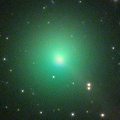
|
Now it is very bright as 6.8 mag (June 5, Chris Wyatt). It approaches to Sun down to 0.9 a.u. in June, and brightens up to 5.5 mag. In the Southern Hemisphere, it stays observable in good condition for a long time after this. In the Northern Hemisphere, it is not observable until late June.
Date(TT) R.A. (2000) Decl. Delta r Elong. m1 Best Time(A, h)
June 6 7 32.35 -17 59.4 1.006 0.943 55 6.0 20:56 ( 78,-15)
June 13 8 15.84 -15 6.6 0.920 0.920 56 5.6 21:01 ( 79,-11)
|
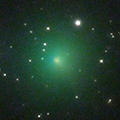
|
Now it is very bright as 7.5 mag (June 5, Chris Wyatt). It will approach to Sun down to 0.3 a.u. on July 3, and it is expected to brighten up to 2.5 mag. In the Southern Hemisphere, it stays observable in good condition until early June when it brightens up to 8 mag. But it will not be observable around the perihelion passage. In the Northern Hemisphere, it is not observable now. It will appear in the evening sky at 3-4 mag in mid July, then it stays observable while getting fainter.
Date(TT) R.A. (2000) Decl. Delta r Elong. m1 Best Time(A, h)
June 6 6 2.77 1 36.2 1.585 0.813 26 7.6 20:56 (109,-22)
June 13 6 1.01 6 52.2 1.541 0.660 18 6.6 21:01 (120,-25)
|
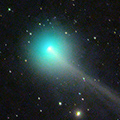
|
It brightened up to 4.7 mag in early May (May 2, Marco Goiato). However, it is fading and getting diffused after that. It has already faded down to 7.3 mag (May 21, Mitsunori Tsumura). It is not observable until August after this.
Date(TT) R.A. (2000) Decl. Delta r Elong. m1 Best Time(A, h)
June 6 5 29.44 43 18.7 1.265 0.495 21 8.2 20:56 (144, 2)
June 13 5 49.39 39 33.2 1.491 0.600 17 9.3 21:01 (143, -2)
|
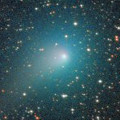
|
Now it is 8.4 mag (May 27, Charles S. Morris). It stays bright as 8-9 mag until July. It is observable in good condition in the Northern Hemisphere. In the Southern Hemisphere, it is not observable until late June.
Date(TT) R.A. (2000) Decl. Delta r Elong. m1 Best Time(A, h)
June 6 11 16.62 61 17.7 1.667 1.672 72 8.2 20:56 (148, 54)
June 13 11 42.61 55 58.0 1.686 1.699 73 8.3 21:01 (139, 55)
|
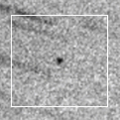
|
It will approach to Sun down to 0.34 a.u. and brighten up to 7 mag in June. In the Southern Hemisphere, it will appear in the evening sky at 7 mag in early July. Then it stays observable in good condition while the comet will be fading. In the Northern Hemisphere, it is not observable until mid August when the comet will fade down to 12 mag.
Date(TT) R.A. (2000) Decl. Delta r Elong. m1 Best Time(A, h)
June 6 4 51.63 26 51.9 1.609 0.603 4 9.8 3:01 (222,-14)
June 13 5 40.05 26 41.0 1.481 0.476 4 8.9 21:01 (136,-13)
|
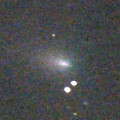
|
Recovered from SWAN images after 24-year blank. Now it is very bright as 10.2 mag (May 31, Marco Goiato). It stays 10-11 mag until August. In the Southern Hemisphere, it stays observable in the morning sky for a long time. In the Northern Hemisphere, it is too low to observe until July.
Date(TT) R.A. (2000) Decl. Delta r Elong. m1 Best Time(A, h)
June 6 2 16.71 9 11.5 1.984 1.382 40 10.0 3:01 (260, 2)
June 13 2 40.01 10 16.9 1.977 1.392 41 10.1 2:58 (259, 3)
|
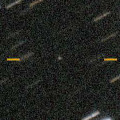
|
Now it is 15.9 mag (May 31, Artyom Novichonok). It was expected to brighten rapidly up to 9.5 mag in June. But actually, it is much fainter than expected. It has finally started brightening in late May. It is not observable in June. It will be observable in good condition after July while the comet will be fading.
Date(TT) R.A. (2000) Decl. Delta r Elong. m1 Best Time(A, h)
June 6 7 25.25 21 2.1 0.430 0.703 34 11.2 20:56 (112, 5)
June 13 6 38.78 25 27.1 0.436 0.611 16 10.3 21:01 (127, -6)
|
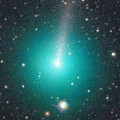
|
Now it is 11.2 mag (May 29, Paul Camilleri). It continued brightening for a while even after the perihelion passage on Mar. 15. It will be fading after this. It stays observable for a long time in the Northern Hemisphere. It is observable in the evening sky after this also in the Southern Hemisphere. It seems to be a fragment of C/1988 A1 (Liller), like C/1996 Q1 (Tabur) and C/2015 F3 (SWAN).
Date(TT) R.A. (2000) Decl. Delta r Elong. m1 Best Time(A, h)
June 6 11 38.49 42 52.2 1.453 1.652 81 11.2 20:56 (116, 62)
June 13 11 48.28 36 20.0 1.591 1.744 80 11.8 21:01 (103, 57)
|
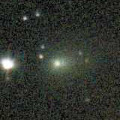
|
Now it is 12.8 mag (May 26, Paul Camilleri). Brightening very rapidly. It will brighten up to 8-9 mag from summer to autumn. It will be observable in excellent condition in the Southern Hemisphere. It locates very low around the high light in the Northern Hemisphere.
Date(TT) R.A. (2000) Decl. Delta r Elong. m1 Best Time(A, h)
June 6 12 39.40 -2 9.2 1.126 1.800 114 11.9 20:56 ( 30, 48)
June 13 12 41.65 -2 52.3 1.146 1.756 108 11.7 21:01 ( 39, 44)
|
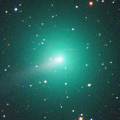
|
Fragment of C/1844 Y1 (Great Comet). It brightened up to 7.0 mag in late March ((Mar. 30, Charles S. Morris). But the nucleus was split into some fragments, and it is fading after that. Now it is 9.1 mag (May 17, Sandor Szabo). It approached to Sun down to 0.25 a.u. on May 31. In the Northern Hemisphere, it is not observable after this. In the Southern Hemisphere, it appears in the morning sky in late June, but it locates extremely low.
Date(TT) R.A. (2000) Decl. Delta r Elong. m1 Best Time(A, h)
June 6 4 2.45 10 33.0 1.054 0.322 17 11.7 3:01 (242,-18)
June 13 4 36.27 6 18.0 1.271 0.482 20 13.9 2:58 (244,-22)
|
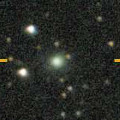
|
Now it is 14.6 mag (June 1, Thomas Lehmann). It will brighten up to 10.5 mag from 2020 December to 2021 January. In the Northern Hemisphere, it stays observable in good condition while the comet will be brightening gradually, but it is not observable at the high light. In the Southern Hemisphere, it is not observable for a long time, but it will be observable in good condition after the high light.
Date(TT) R.A. (2000) Decl. Delta r Elong. m1 Best Time(A, h)
June 6 12 13.82 69 25.0 2.887 2.806 75 13.3 20:56 (165, 53)
June 13 12 4.50 65 57.4 2.867 2.743 72 13.2 21:01 (156, 53)
|
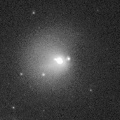
|
Appearing in the morning sky. Now it is 14.9 mag (May 27, Slooh.com Canary Islands Observatory).
Date(TT) R.A. (2000) Decl. Delta r Elong. m1 Best Time(A, h)
June 6 2 15.62 22 13.8 6.582 5.806 37 13.8 3:01 (249, 9)
June 13 2 20.59 22 44.1 6.515 5.807 42 13.8 2:58 (251, 14)
|

|
Now it is 13.5 mag (May 17, Thomas Lehmann). It stays bright as 13 mag until June. In the Southern Hemisphere, it will never be observable again.
Date(TT) R.A. (2000) Decl. Delta r Elong. m1 Best Time(A, h)
June 6 2 8.27 73 17.6 4.184 3.706 55 13.9 3:01 (200, 33)
June 13 2 26.35 75 35.3 4.195 3.741 57 14.0 2:58 (197, 34)
|
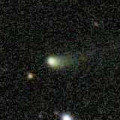
|
Now it is 14.2 mag (May 24, Paul Camilleri). It stays 13-14 mag from 2020 to 2021. It stays observable in good condition for a while.
Date(TT) R.A. (2000) Decl. Delta r Elong. m1 Best Time(A, h)
June 6 12 31.06 14 2.6 2.756 3.178 105 14.2 20:56 ( 48, 61)
June 13 12 32.70 13 4.7 2.830 3.163 99 14.2 21:01 ( 57, 56)
|
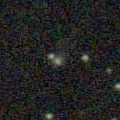
|
Now it is 15.1 mag (May 29, Toshihiko Ikemura, Hirohisa Sato). It will brighten up to 13 mag in 2021. In 2020, it is observable at 15 mag in good condition from spring to summer.
Date(TT) R.A. (2000) Decl. Delta r Elong. m1 Best Time(A, h)
June 6 14 3.85 -21 29.3 4.102 4.923 140 15.0 21:03 ( 0, 33)
June 13 13 59.85 -21 46.8 4.138 4.883 132 15.0 21:01 ( 8, 33)
|
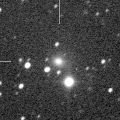
|
Now it is bright as 13.9 mag (Apr. 24, Chris Wyatt). It stays 15 mag until summer. It stays observable for a long time in the Southern Hemisphere. It is not observable until August in the Northern Hemisphere.
Date(TT) R.A. (2000) Decl. Delta r Elong. m1 Best Time(A, h)
June 6 3 5.66 -36 18.7 4.162 3.837 64 15.0 3:01 (294,-32)
June 13 3 10.19 -35 45.5 4.145 3.865 67 15.1 2:58 (296,-28)
|
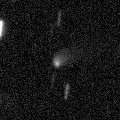
|
Now it is 15.3 mag (May 22, R. Carstens). It stays 14-15 mag until 2021. In the Southern Hemisphere, it stays observable in good condition for a long time. In the Northern Hemisphere, it is not observable until June in 2021.
Date(TT) R.A. (2000) Decl. Delta r Elong. m1 Best Time(A, h)
June 6 15 26.22 -84 33.6 4.385 4.938 117 15.1 22:27 ( 0,-30)
June 13 15 2.57 -84 19.7 4.356 4.911 117 15.1 21:36 ( 0,-29)
|
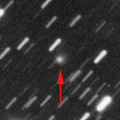
|
Now it is 15.4 mag (June 1, Thomas Lehmann). It is expected to be observable at 5-6 mag for a long time from 2022 to 2023. In the Northern Hemisphere, it is not observable at the high light from 2022 summer to 2023 summer. In the Southern Hemisphere, it is only visible in the extremely low sky in summer in 2020. But it will be observable in good condition at the high light.
Date(TT) R.A. (2000) Decl. Delta r Elong. m1 Best Time(A, h)
June 6 17 51.19 53 25.1 8.724 9.007 103 15.2 0:53 (180, 72)
June 13 17 46.08 53 24.6 8.668 8.956 103 15.2 0:21 (180, 72)
|
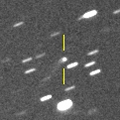
|
Now it is 15.3 mag (May 29, Toshihiko Ikemura, Hirohisa Sato). It stays 15-16 mag for a long time until 2021.
Date(TT) R.A. (2000) Decl. Delta r Elong. m1 Best Time(A, h)
June 6 20 32.60 10 57.2 3.917 4.476 117 15.5 3:01 (340, 65)
June 13 20 25.71 12 25.5 3.835 4.475 123 15.4 2:58 (359, 67)
|
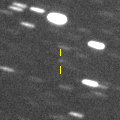
|
Now it is 16.7 mag (June 2, Toshihiko Ikemura, Hirohisa Sato). It will brighten up to 15.5 mag from June to August, and it will be observable in good condition.
Date(TT) R.A. (2000) Decl. Delta r Elong. m1 Best Time(A, h)
June 6 19 25.40 -1 53.8 1.239 2.108 138 15.8 2:28 ( 0, 53)
June 13 19 25.57 -1 20.9 1.190 2.096 143 15.7 2:00 ( 0, 54)
|

|
Now it is 16.0 mag (May 14, iTelescope Observatory, Siding Spring). It will brighten up to 13.5 mag in spring in 2021. In the Southern Hemisphere, it stays observable in good condition for a long time. In the Northern Hemisphere, it is not observable until spring in 2021.
Date(TT) R.A. (2000) Decl. Delta r Elong. m1 Best Time(A, h)
June 6 22 30.31 -55 28.2 3.950 4.434 112 16.0 3:01 (339, -6)
June 13 22 21.91 -57 17.5 3.825 4.394 117 15.8 2:58 (344, -5)
|
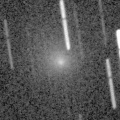
|
Now it is 14.1 mag (May 21, Thomas Lehmann). It will fade out rapidly after this, and it will be fainter than 18 mag in late June. It stays observable in good condition in the Northern Hemisphere. It will be unobservable after this in the Southern Hemisphere.
Date(TT) R.A. (2000) Decl. Delta r Elong. m1 Best Time(A, h)
June 6 8 49.66 65 6.0 1.270 1.102 56 15.9 20:56 (149, 37)
June 13 9 7.93 59 48.5 1.475 1.185 52 16.6 21:01 (143, 34)
|
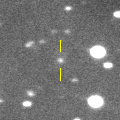
|
Now it is 16.0 mag (May 29, Toshihiko Ikemura, Hirohisa Sato). It will brighten up to 12 mag in winter in 2022. In the Northern Hemisphere, it stays observable in good condition for a long time. In the Southern Hemisphere, it is not observable until 2021 November.
Date(TT) R.A. (2000) Decl. Delta r Elong. m1 Best Time(A, h)
June 6 0 26.93 52 1.1 6.602 6.135 58 16.2 3:01 (228, 40)
June 13 0 32.11 53 2.4 6.504 6.091 61 16.1 2:58 (227, 44)
|
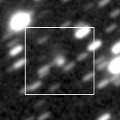
|
Now it is 16.5 mag (May 29, Toshihiko Ikemura, Hirohisa Sato). It will stay at 15 mag for a long time from 2021 to 2022. In the Northern Hemisphere, it stays observable in good condition while brightening gradually. In the Southern Hemisphere, it stays locating low for a long time.
Date(TT) R.A. (2000) Decl. Delta r Elong. m1 Best Time(A, h)
June 6 18 42.60 34 21.9 5.786 6.322 117 16.3 1:45 ( 0, 89)
June 13 18 36.03 34 11.1 5.718 6.291 120 16.3 1:11 ( 0, 89)
|
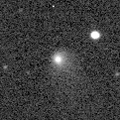
|
It brightened up to 13.8 mag in autumn in 2019 (Sept. 3, Chris Wyatt). Now it is fading slowly. Now it is 15.9 mag (May 13, iTelescope Observatory, Siding Spring). In 2020, it stays observable in good condition while the comet will be fading from 16 to 17 mag.
Date(TT) R.A. (2000) Decl. Delta r Elong. m1 Best Time(A, h)
June 6 0 36.02 -2 38.1 5.966 5.671 68 16.3 3:01 (284, 15)
June 13 0 37.79 -2 3.5 5.900 5.711 74 16.3 2:58 (288, 20)
|
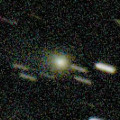
|
It brightened up to 10.8 mag (Apr. 20, Sandor Szabo). Now it is 14.6 mag (May 28, Charles S. Morris). It will fade out rapidly, and will be fainter than 18 mag in June.
Date(TT) R.A. (2000) Decl. Delta r Elong. m1 Best Time(A, h)
June 6 9 30.32 24 49.7 1.319 1.228 61 16.4 20:56 ( 99, 33)
June 13 10 2.55 22 8.0 1.426 1.326 63 17.1 21:01 ( 96, 31)
|

|
It brightened up to 13.2 mag from spring to autumn in 2019 (June 30, Thomas Lehmann). Now it is fading slowly. It has already faded down to 16.0 mag (Apr. 25, iTelescope Observatory, Siding Spring). In the Southern Hemisphere, it stays observable for a long time. It becomes observable also in the Northern Hemisphere, but it locates low.
Date(TT) R.A. (2000) Decl. Delta r Elong. m1 Best Time(A, h)
June 6 0 11.82 -30 24.5 4.049 4.115 86 16.5 3:01 (309, 2)
June 13 0 11.56 -30 16.2 3.985 4.153 92 16.5 2:58 (313, 6)
|

|
Now it is 15.6 mag (May 22, ATLAS-MLO, Mauna Loa). It is observable at 16 mag in 2020. It is observable in excellent condition in the Southern Hemisphere. It locates somewhat low in the Northern Hemisphere.
Date(TT) R.A. (2000) Decl. Delta r Elong. m1 Best Time(A, h)
June 6 19 34.03 -29 45.6 5.820 6.669 144 16.5 2:37 ( 0, 25)
June 13 19 26.88 -29 42.1 5.767 6.682 152 16.6 2:02 ( 0, 25)
|

|
Now it is 18.8 mag (May 24, Toshihiko Ikemura, Hirohisa Sato). It will brighten very rapidly, and brighten up to 14.5 mag from August to September. In the Northern Hemisphere, it stays observable for a long time, although it becomes extremely low in early September. In the Southern Hemisphere, it is observable only until mid June.
Date(TT) R.A. (2000) Decl. Delta r Elong. m1 Best Time(A, h)
June 6 22 40.16 32 51.0 1.495 1.674 81 17.1 3:01 (262, 57)
June 13 22 47.20 40 34.7 1.370 1.588 82 16.7 2:58 (248, 61)
|
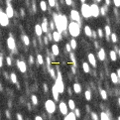
|
Now it is 16.8 mag (May 28, Toshihiko Ikemura, Hirohisa Sato). It will be observable at 16.5-17 mag from spring in 2020 to summer in 2021.
Date(TT) R.A. (2000) Decl. Delta r Elong. m1 Best Time(A, h)
June 6 19 16.42 24 4.9 4.168 4.787 122 16.8 2:19 ( 0, 79)
June 13 19 6.76 23 51.1 4.093 4.773 126 16.7 1:42 ( 0, 79)
|
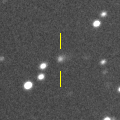
|
Now it is 16.9 mag (May 18, ATLAS-MLO, Mauna Loa). It stays observable at 16-17 mag from 2020 to 2021. It locates somewhat low in the Northern Hemisphere.
Date(TT) R.A. (2000) Decl. Delta r Elong. m1 Best Time(A, h)
June 6 10 49.57 -16 17.8 6.426 6.585 94 16.7 20:56 ( 49, 22)
June 13 10 52.49 -15 54.2 6.528 6.586 88 16.8 21:01 ( 55, 18)
|
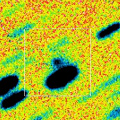
|
Now it is 18.8 mag (May 13, iTelescope Observatory, Siding Spring). It brightens up to 13.5 mag in winter. But it is not observable at high light. In the Southern Hemisphere, it stays observable in good condition until autumn when the comet will brighten up to 14 mag. It stays locating very low in the Northern Hemisphere.
Date(TT) R.A. (2000) Decl. Delta r Elong. m1 Best Time(A, h)
June 6 18 52.09 -46 53.3 1.897 2.800 146 17.0 1:55 ( 0, 8)
June 13 18 45.87 -47 5.5 1.837 2.770 151 16.8 1:21 ( 0, 8)
|
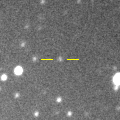
|
Now it is 17.4 mag (May 9, P. Camilleri, H. Williams, J. Oey). It is expected to brighten up to 13 mag in 2022. In 2020, it is observable in excellent condition in the Southern Hemisphere. In the Northern Hemisphere, it is not observable. It will be observable from autumn to winter, but it locating extremely low.
Date(TT) R.A. (2000) Decl. Delta r Elong. m1 Best Time(A, h)
June 6 6 46.87 -25 43.8 7.686 7.156 55 17.0 20:56 ( 77,-28)
June 13 6 52.00 -25 32.8 7.680 7.116 53 16.9 21:01 ( 80,-34)
|

|
Now it is 17.1 mag (May 19, ATLAS-MLO, Mauna Loa). It will brighten up to 16.5 mag and will be observable in good condition from June to October.
Date(TT) R.A. (2000) Decl. Delta r Elong. m1 Best Time(A, h)
June 6 20 32.76 10 58.9 1.613 2.266 117 17.1 3:01 (340, 65)
June 13 20 34.95 12 29.8 1.545 2.249 121 17.0 2:58 (353, 67)
|
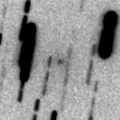
|
Now it is 17.0 mag (May 23, Katsumi Yoshimoto). It brightens up to 17 mag from June to July. It is observable in excellent condition in the Northern Hemisphere. In the Southern Hemisphere, it is observable only in the extremely low sky until early June and after August.
Date(TT) R.A. (2000) Decl. Delta r Elong. m1 Best Time(A, h)
June 6 23 52.37 45 13.0 1.728 1.585 64 17.2 3:01 (238, 45)
June 13 23 33.82 50 42.8 1.599 1.592 71 17.0 2:58 (230, 52)
|
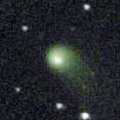
|
It brightened up to 12-13 mag from 2018 to 2019. Now it is fading. It has already faded down to 16.9 mag (May 10, P. Camilleri, J. Oey). In the Southern Hemisphere, it stays observable in good condition for a long time. It will never be observable after this in the Northern Hemisphere.
Date(TT) R.A. (2000) Decl. Delta r Elong. m1 Best Time(A, h)
June 6 9 13.91 -62 2.3 5.336 5.581 98 17.1 20:56 ( 29,-22)
June 13 9 15.44 -60 52.3 5.432 5.628 95 17.2 21:01 ( 32,-25)
|
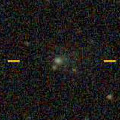
|
Now it is 17.0 mag (May 15, ATLAS-MLO, Mauna Loa). It will fade out after this, and will be fainter than 18 mag in July.
Date(TT) R.A. (2000) Decl. Delta r Elong. m1 Best Time(A, h)
June 6 12 46.71 -2 38.3 1.454 2.110 116 17.2 20:56 ( 27, 49)
June 13 12 52.64 -3 13.3 1.525 2.115 111 17.3 21:01 ( 36, 45)
|

|
Now it is 17.7 mag (May 26, ATLAS-MLO, Mauna Loa). It stays observable at 16-17 mag for a long time until 2024.
Date(TT) R.A. (2000) Decl. Delta r Elong. m1 Best Time(A, h)
June 6 15 48.46 -16 41.9 8.891 9.865 162 17.2 22:47 ( 0, 38)
June 13 15 44.31 -16 23.8 8.917 9.848 155 17.2 22:15 ( 0, 39)
|
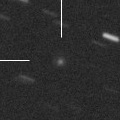
|
Now it is 17.6 mag (May 24, Toshihiko Ikemura, Hirohisa Sato). It will fade out after this, and will be fainter than 18 mag in July. Charles S. Morris reported that it is fading very rapidly down to 18.4 mag on May 26.
Date(TT) R.A. (2000) Decl. Delta r Elong. m1 Best Time(A, h)
June 6 15 8.73 1 57.8 2.783 3.653 143 17.3 22:07 ( 0, 57)
June 13 15 4.44 1 5.4 2.872 3.689 137 17.4 21:36 ( 0, 56)
|
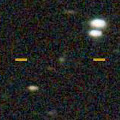
|
Now it is 17.4 mag (May 23, ATLAS-MLO, Mauna Loa). It became brighter than orignally predicted. It stays observable at 17 mag in good condition until autumn.
Date(TT) R.A. (2000) Decl. Delta r Elong. m1 Best Time(A, h)
June 6 12 40.85 -8 7.5 1.568 2.221 117 17.4 20:56 ( 26, 43)
June 13 12 44.25 -8 43.4 1.620 2.204 111 17.3 21:01 ( 35, 40)
|

|
It will pass the perihelion in 2021, and it is predicted to be observable at 17-18 mag from 2020 to 2022. However, it has not been observed at all since 2015. It was not detected, fainter than 20.5 mag, in 2017 May (Werner Hasubick).
Date(TT) R.A. (2000) Decl. Delta r Elong. m1 Best Time(A, h)
June 6 20 41.02 -21 51.3 5.336 6.019 128 17.4 3:01 (348, 32)
June 13 20 40.26 -21 53.3 5.242 6.007 135 17.4 2:58 (355, 33)
|
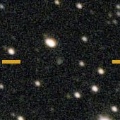
|
Now it is 17.3 mag (Apr. 23, D. Buczynski). It will be observable at 16.5-17 mag from 2020 to 2021. In the Southern Hemisphere, it is not observable until summer in 2021.
Date(TT) R.A. (2000) Decl. Delta r Elong. m1 Best Time(A, h)
June 6 2 2.28 68 22.9 6.801 6.240 52 17.5 3:01 (206, 32)
June 13 2 4.07 68 51.8 6.758 6.226 54 17.4 2:58 (206, 34)
|

|
Now it is 16.8 mag (May 20, R. Carstens). It will brighten up to 15.5 mag in early 2021. In 2020, it stays observable at 17 mag until November in the Southern Hemisphere, or until July in the Northern Hemisphere.
Date(TT) R.A. (2000) Decl. Delta r Elong. m1 Best Time(A, h)
June 6 14 7.57 -31 35.1 2.490 3.345 141 17.5 21:06 ( 0, 23)
June 13 14 3.41 -31 2.6 2.496 3.290 134 17.5 21:01 ( 6, 24)
|

|
Now it is 18.7 mag (Apr. 18, iTelescope Observatory, Siding Spring). It brightens up to 16 mag from summer to winter. In the Southern Hemisphere, it is observable in excellent condition. In the Northern Hemisphere, it is not observable until late October.
Date(TT) R.A. (2000) Decl. Delta r Elong. m1 Best Time(A, h)
June 6 21 55.72 -54 32.9 1.636 2.284 117 17.7 3:01 (343, -3)
June 13 22 5.56 -56 9.8 1.545 2.235 120 17.5 2:58 (346, -4)
|
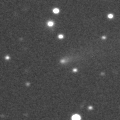
|
It brightened up to 15.9 mag in spring (Mar. 17, Purple Mountain Observatory, XuYi Station). Now it is fading. It has already faded down to 18.3 mag (May 24, Toshihiko Ikemura, Hirohisa Sato). It will be fainter than 18 mag in late June.
Date(TT) R.A. (2000) Decl. Delta r Elong. m1 Best Time(A, h)
June 6 13 4.43 -1 44.1 1.630 2.310 119 17.5 20:56 ( 21, 51)
June 13 13 8.18 -2 33.0 1.718 2.329 114 17.6 21:01 ( 31, 48)
|

|
Now it is 17.6 mag (May 21, ATLAS-MLO, Mauna Loa). It will be fading slowly after this. It is observable in good condition in the Northern Hemisphere. In the Southern Hemisphere, it is observable in the extremely low sky only in 2021 spring.
Date(TT) R.A. (2000) Decl. Delta r Elong. m1 Best Time(A, h)
June 6 12 37.52 51 10.4 8.876 8.879 86 17.6 20:56 (144, 68)
June 13 12 37.07 50 20.9 8.960 8.892 82 17.6 21:01 (135, 65)
|
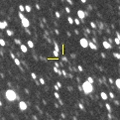
|
Now it is 19.9 mag (May 29, Toshihiko Ikemura, Hirohisa Sato). It stays observable at 18 mag for a long time from 2019 to 2021. However, it is much fainter than this ephemeris recently.
Date(TT) R.A. (2000) Decl. Delta r Elong. m1 Best Time(A, h)
June 6 19 6.48 -18 48.3 6.801 7.692 149 17.6 2:09 ( 0, 36)
June 13 19 3.23 -19 22.9 6.750 7.695 157 17.6 1:38 ( 0, 36)
|
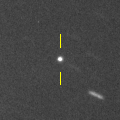
|
It brightened up to 15.9 mag in February and March (Feb. 18, Toshihiko Ikemura, Hirohisa Sato). Now it is fading. It has already faded down to 17.7 mag (May 15, A. Diepvens). It will be fainter than 18 mag in late June.
Date(TT) R.A. (2000) Decl. Delta r Elong. m1 Best Time(A, h)
June 6 10 39.40 -9 40.7 1.357 1.691 89 17.6 20:56 ( 56, 25)
June 13 10 49.69 -12 19.0 1.431 1.707 86 17.7 21:01 ( 58, 20)
|
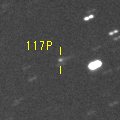
|
Now it is 17.8 mag (May 24, Toshihiko Ikemura, Hirohisa Sato). It will brighten up to 13 mag in 2022. In 2020, it is observable at 17.5 mag in good condition in spring. It locates somewhat low in the Southern Hemisphere.
Date(TT) R.A. (2000) Decl. Delta r Elong. m1 Best Time(A, h)
June 6 10 19.84 19 7.9 4.515 4.356 74 17.8 20:56 ( 86, 40)
June 13 10 23.80 18 32.7 4.601 4.342 68 17.8 21:01 ( 90, 34)
|
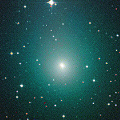
|
It brightened up to 8.3 mag in last September (Sept. 20, Maik Meyer). Now it is fading. It has already faded down to 17.1 mag (Apr. 5, iTelescope Observatory, Siding Spring). In the Southern Hemisphere, it stays observable for a long time after this. In the Northern Hemisphere, it will never be observable again.
Date(TT) R.A. (2000) Decl. Delta r Elong. m1 Best Time(A, h)
June 6 2 32.41 -70 29.5 3.475 3.729 96 17.8 3:01 (336,-35)
June 13 2 56.52 -72 32.0 3.504 3.798 99 18.0 2:58 (338,-35)
|
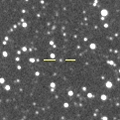
|
Now it is 17.1 mag (May 18, ATLAS-HKO, Haleakala). It is observable at 17-18 mag in good condition in 2020 summer.
Date(TT) R.A. (2000) Decl. Delta r Elong. m1 Best Time(A, h)
June 6 19 50.26 28 54.8 8.506 8.962 113 17.9 2:52 ( 0, 84)
June 13 19 47.05 29 35.1 8.444 8.955 117 17.9 2:22 ( 0, 85)
|
|
![]()
 C/2020 H2 ( Pruyne )
C/2020 H2 ( Pruyne ) C/2019 L3 ( ATLAS )
C/2019 L3 ( ATLAS ) C/2018 U1 ( Lemmon )
C/2018 U1 ( Lemmon ) C/2017 B3 ( LINEAR )
C/2017 B3 ( LINEAR ) 210P/Christensen
210P/Christensen C/2018 A6 ( Gibbs )
C/2018 A6 ( Gibbs ) C/2017 U7 ( PanSTARRS )
C/2017 U7 ( PanSTARRS ) C/2020 H4 ( Leonard )
C/2020 H4 ( Leonard ) C/2017 Y2 ( PanSTARRS )
C/2017 Y2 ( PanSTARRS ) C/2019 C1 ( ATLAS )
C/2019 C1 ( ATLAS ) 17P/Holmes
17P/Holmes C/2019 T4 ( ATLAS )
C/2019 T4 ( ATLAS ) 257P/Catalina
257P/Catalina C/2020 K3 ( Leonard )
C/2020 K3 ( Leonard ) C/2017 M4 ( ATLAS )
C/2017 M4 ( ATLAS ) 87P/Bus
87P/Bus C/2020 F2 ( ATLAS )
C/2020 F2 ( ATLAS ) P/2019 LM4 ( Palomar )
P/2019 LM4 ( Palomar ) 278P/McNaught
278P/McNaught C/2014 F3 ( Sheppard-Trujillo )
C/2014 F3 ( Sheppard-Trujillo ) C/2019 T3 ( ATLAS )
C/2019 T3 ( ATLAS ) 28P/Neujmin 1
28P/Neujmin 1 162P/Siding Spring
162P/Siding Spring P/2019 Y2 ( Fuls )
P/2019 Y2 ( Fuls ) C/2010 U3 ( Boattini )
C/2010 U3 ( Boattini ) C/2017 K5 ( PanSTARRS )
C/2017 K5 ( PanSTARRS ) 124P/Mrkos
124P/Mrkos 117P/Helin-Roman-Alu 1
117P/Helin-Roman-Alu 1 C/2018 W2 ( Africano )
C/2018 W2 ( Africano ) A/2019 O3
A/2019 O3![]()












































